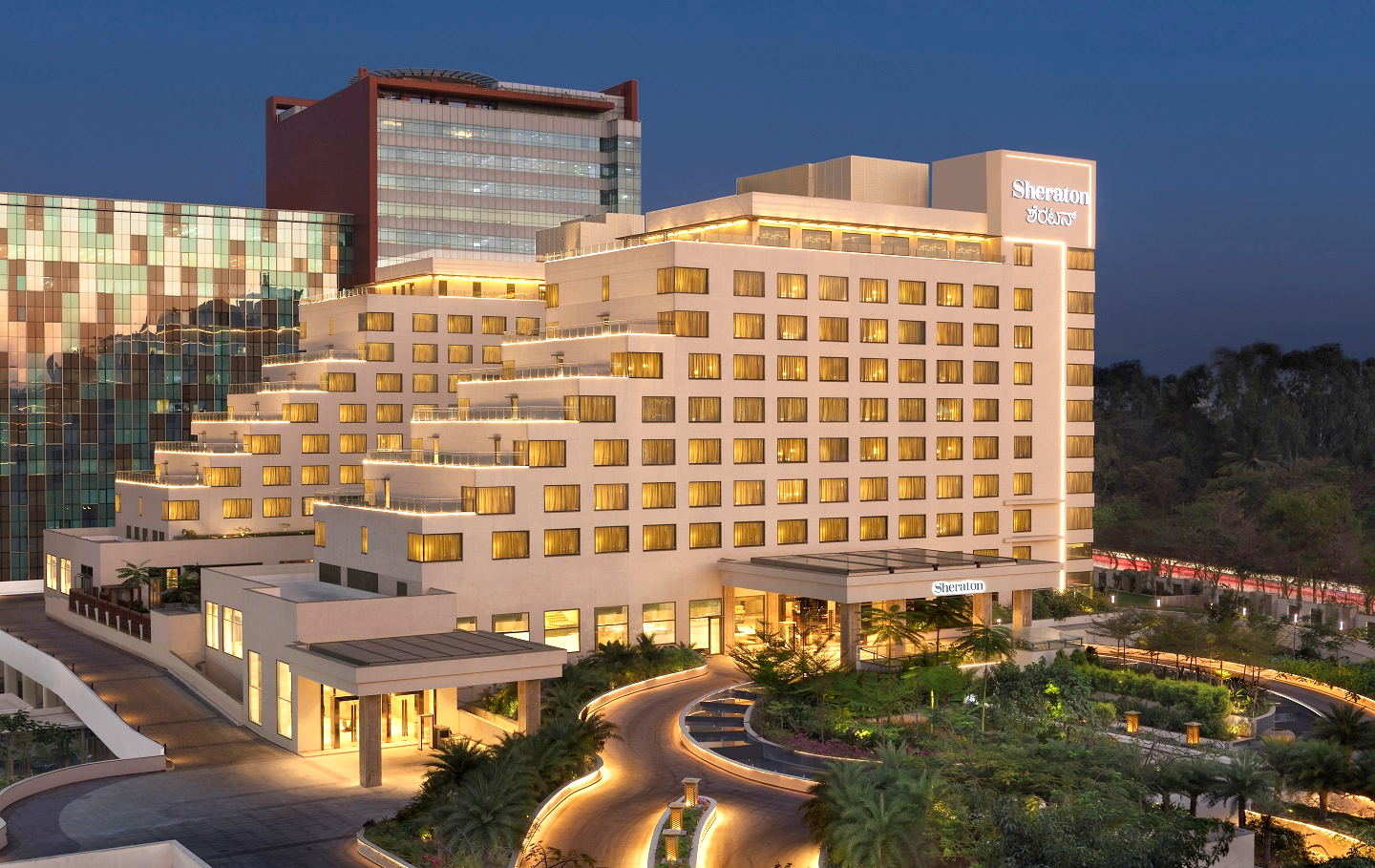
Right in the heart of India’s Silicon Valley, Sheraton Grand Bengaluru Whitefield Hotel & Convention Center is located in Bengaluru's first integrated township (Photo: Sheraton Grand Bengaluru Whitefield Hotel & Convention Center)
As the red-eye flight finally touches down at Bengaluru airport, my exhaustion is overtaken by excitement. It has been 10 years since I set foot in what is known as the “Garden City of India”. All I have heard about it since has revolved around the burgeoning IT industry and horrifying traffic conditions. Groggily passing through immigration and a short stop at the baggage belts, the adventure kicks off with an hour’s drive to the Sheraton Grand Bengaluru Whitefield Hotel & Convention Centre. We were invited to experience the sixth instalment of Sheraton Hotels’ “Heart for the City” global tour, which so far has touched down in Saint-Hyacinthe, Seattle, Sydney, São Paulo and Cairo. Not only did we get the chance to attend the main event, but we also toured the vibrant city of Bengaluru, formerly known as Bangalore.
At the entrance of Sheraton Bengaluru, I am greeted with warm smiles and a tasty drink before being whisked off to my room where I find a plate of sliced mangoes — and my heart is completely won. Indian mangoes are sweet, juicy and by far the most satisfying. So it is only after stuffing myself with the fragrant fruit that I take in my comfortable room with a pool view. It is fitted with all the necessary amenities, including a tub and rain shower in the bathroom, an exceptionally comfortable bed, television set and even a bottle of bubbly. The headboard has panels of a famed monument, which I learn during the tour the next day, is a feature that is found in every room at the hotel.
sheblrswgr-238195-king_deluxe_guest_room_-_pool_view-med.jpg
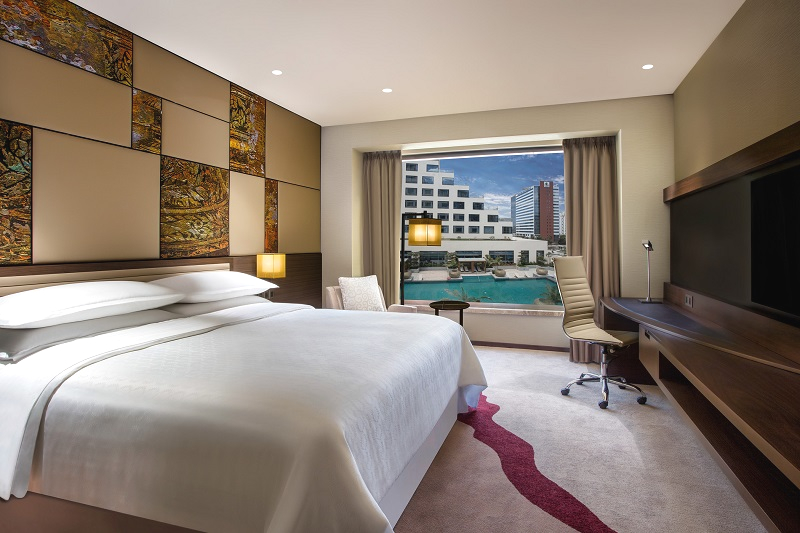
After breakfast, our morning tour of Sheraton Grand Bengaluru Whitefield Hotel begins in the lobby, where we see the first of many chandeliers designed specially for the hotel by Czech company Lasvit. Next, we take the lift up to the Shine Spa, a luxurious space that has an Ayurveda room, a couples room and three single rooms. After having a look at an executive suite, we head up to the eighth floor to have a peek at the presidential suite — a stunning space that has a generous living room, contemporary master bedroom, oversized spa tub and a sizeable balcony that faces the pool.
I vaguely remember Whitefield as a part of Bengaluru that was hardly developed and comprised mostly of green fields. In stark contrast, today, I see many shopping malls, hotels and offices. From that balcony we have a sweeping view of Whitefield and the entire Sheraton property. With 360 guest rooms, which includes 39 suites, the Sheraton Whitefield Hotel & Convention centre is the city’s largest premium meeting destination. The convention centre is next to the hotel — an expansive space that hosts all kinds of events from banquets to weddings. Another special feature is the art by local Bangalorean artists. At the entrance of the Sheraton Club Lounge, an exclusive members-only space, there is a beautiful lotus sculpture by Gopinath Subbanna.
lakshmiimg-3552.jpg
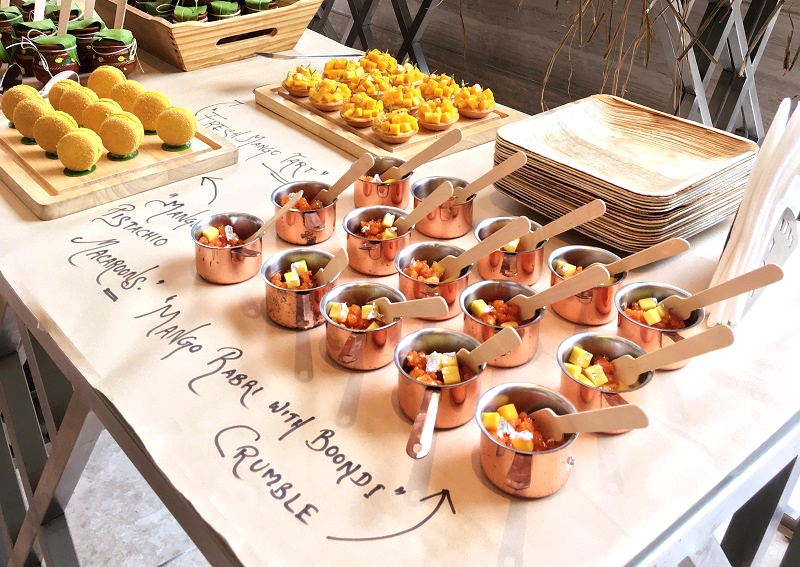
Next on the agenda is a visit to Cubbon Park, but first, a surprise awaits us in the lobby. Executive chef Jatindar Pal has prepared a memorable mango feast— a buffet of 10 mango varieties from all over India. Each type differs in sweetness and level of tartness and even the scent is distinctive. Chef JP also served a range of treats made with mango, satisfying my sweet tooth — fresh mango tarts, mango pistachio macarons and a special treat for fans of Indian sweets, mango Rabri with a Boondi crumble. The savoury side features a tart mango chutney paired with methi thepla (a Gujarati flatbread) and an addictive mango pickle with crunchy jeera (cumin) lavash.
Reluctantly, we had to leave the buffet of my dreams to hop on a bus to our first outing. Bengaluru, the capital of Karnataka, is the third most populous city in India. This cosmopolitan megacity is now dubbed “The Silicon Valley of India”. Our guide for this expedition is Thej from Unventured Expeditions — an experiential travel company that organises tours across India and Southeast Asia. As we drive towards our destination, the fast pace of the city is obvious, from the endless construction to the incredible number of people. We pass by Ulsoor Lake, one of the many places whose mispronounced names stuck even after the colonisers left. Thej explains this is one of the largest lakes in Bengaluru, originally named Halasuru — which translates into city of jackfruit.
My faded memories of Cubbon Park revolve around kindergarten trips and an unfortunate encounter with a red ant hill, but it is just as green as I remember. Right in the heart of the city, Cubbon Park is often referred to as its green lung. It is an endless walk of green with enormous shady trees and bamboo shoots that grow a metre a day. We are told that on Sundays, the place really comes alive with sketch artists, musicians on the bandstand, poetry readings and more. There is even a children’s area with a little train, where summer camps are often held.
lakshmiimg-3578.jpg
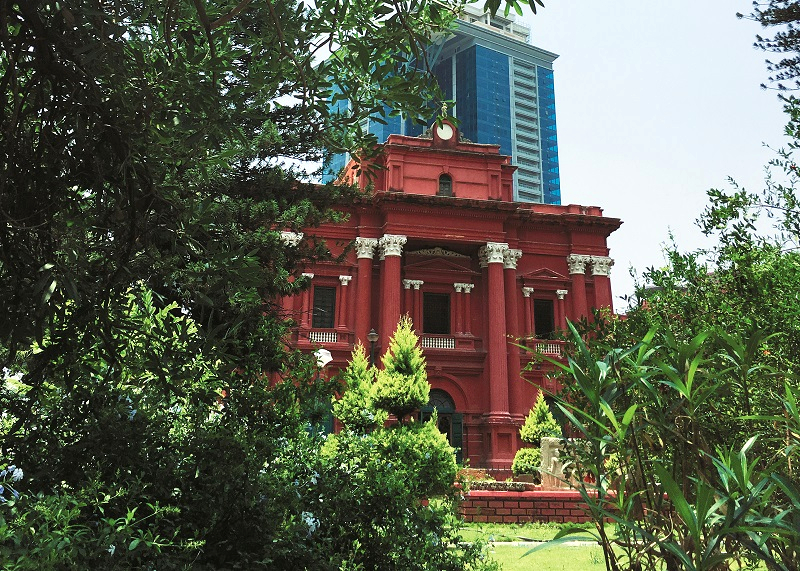
At the other end of the park is the Museum of Archaeology, a Pompeian red building accented with white entablatures. Inside, the museum is filled with artefacts such as clay pots and ancient coins that are over 5,000 years old. Most of the objects in the museum are donations from locals, who found them while excavating land or rebuilding. The upstairs displays mostly older artworks in the 17th-century Tanjore style.
For lunch, we head to The Permit Room, a quirky South Indian restaurant decorated with pop culture posters and unusual art. The extensive tasting menu includes traditional Karnataka, Tamilnadu, Kerala and Andhra favourites with a modern twist. We start with a shot of spicy mango rasam and move on to dishes such as meen moilée kappa (fish with a creamy sauce and tapioca), Haleem samosa and donne biryani. I am sceptical of dessert — Mysore Pak encased in pastry, baked and served with fresh fruit — as I feel that the gloriously sweet ghee Mysore Pak needs no accompaniment. I am pleasantly surprised with the crunch of the pastry and the tart fruit taking an edge off the sweetness.
We then make our way to Bangalore Palace, a Tudor revival building that was completed in 1878. This grand structure has gone through many improvements over the years, and the inside is an informative museum of the city’s history and culture, which we explore with the help of an audio tour. The sprawling grounds around the palace are often used for public events and have hosted performances by Metallica, Iron Maiden, Elton John, David Guetta and many more. Short for time, we hop on the bus to the bustling Commercial Street to shop until we drop. While some buy sarees and others explore the wares in Fabindia, I mosey on over to a sweet shop to carry home as many ghee-filled treats as I can carry.
img-372888.jpg
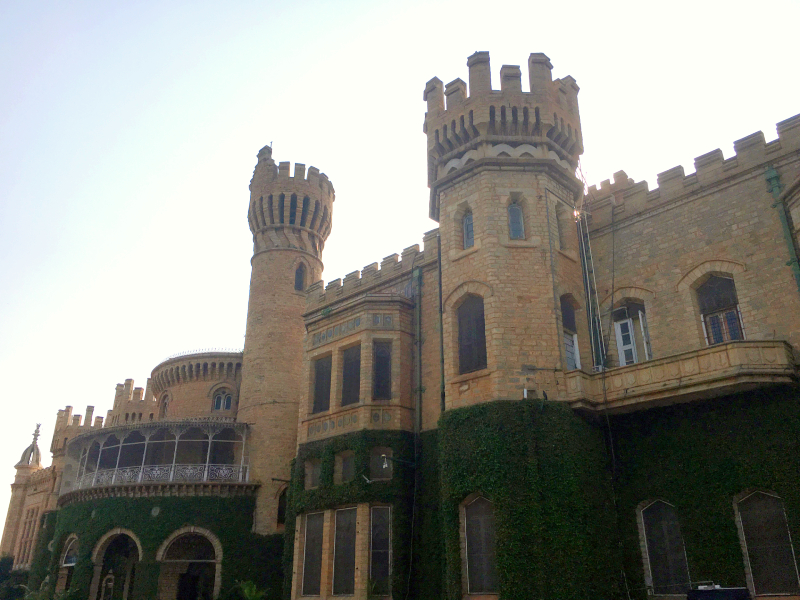
Admittedly, most of us are still full from lunch, but we push on for dinner at Oota, a new restaurant with a modern take on Karnataka cuisine. Filled with dosas, rotis, and spiced curries, biryani and more sweets, we roll ourselves back to the hotel for the night. Each night, Sheraton has a new treat in our room, and this time we are treated to turmeric milk and Indian sweets, freshly made at the hotel.
With a 5:45am start, we head to the countryside for the Nandi Hills and arrived at 8:20am. A cycle tour was organised but, as I am unable to operate anything with two wheels, I sat comfortably in the bus as it followed the group. Nandi Hills, also known as Nadidurg, is a hill fortress with a fort called the Tipu Sultan Fort, named after the 18th century ruler. Looking at the hill, it is easy to see why it was such an important fortress, set high above, to ensure a steep access for foes.
We find ourselves at a family run pottery, watching pots and tandoor ovens being built from scratch. We even have the opportunity to try making our own little pots to take home. Our guide explains that tourists are often taken to such potteries to give the locals a reason to keep their craft going. It is the same story for the silk weavers we visit. Here, we learn how silk is made, which includes the surprising step of immersing the cocoons in boiling water to kill the silkworm and easily extract the silk. Only one variety of silk waits for the worm to burst out as a fully formed moth, and that is Ahimsa silk.
Next, we go to Nandi Halt, a 100-year-old railway station, followed by Bhoga Nandishwara Temple. This ancient Hindu temple is dedicated to the god Shiva. Thej tells us that it is one of the few temples that has been consecrated by a woman. What were once more intricate carvings on the walls have worn away to more simple shapes, but the most beautiful part of the temple is the temple tank — a reservoir built as part of the temple, surrounded by steps that lead into the water.
lakshmiimg-3891.jpg
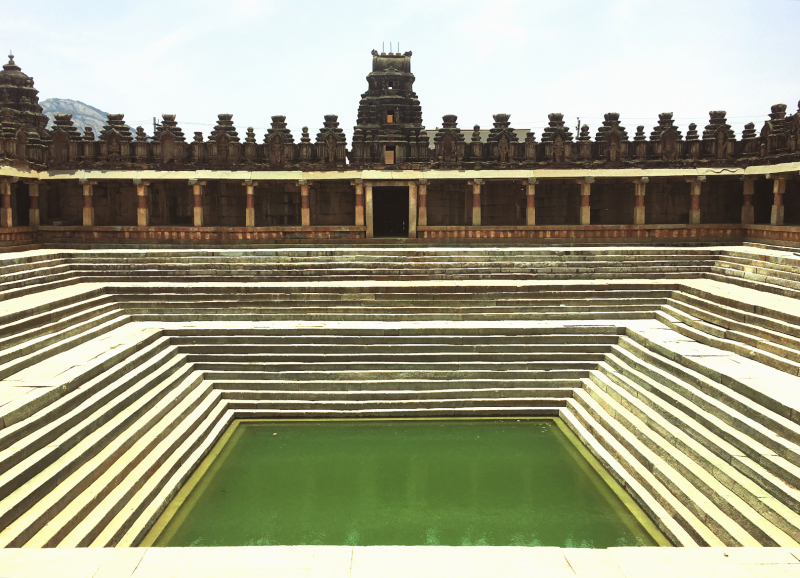
After a satisfying Tali lunch, we head back to the hotel to freshen up before enjoying gin-infused cocktails at the hotel’s Chime Bar. I also had a chance to shake up my own cocktail with pepper-infused gin. We end our evening at the hotel’s Pan-Asian restaurant, InAzia, where general manager Faiz Alam Ansari joins us. He tells us how Sheraton Bengaluru Whitefield really speaks to its community, as many individuals frequent the restaurants and bar for meetings or events. Other meal options available at the hotel include Feast, an all-day dining space and Upper Cut, a grill and barbeque restaurant.
The following afternoon we have a cooking class with chef JP, before we await the main event of our visit. Gathered in the Chime Bar, we listen to the humorous stories of Bengaluru-based comedian Sanjay Manaktala. Then the real party begins — the Sheraton “Heart for the City” celebration takes place at the transformed poolside, with a buzzing bar and numerous food stalls that serve everything from mini-sliders to barbecued meats. Instagrammable vignettes allow the VIP guests to take interesting snaps to remember the event by. The same installations were open to other guests to take a snap over the weekend. The night is topped off with an exceptional performance by the famed dancer and choreographer Terrence Lewis and his Contemporary Dance Company.
The hotel’s transformed night really brings people together, dressed to the nines, to enjoy an incredible evening. The “Heart for the City” really shows itself to be a fun community-driven event. Eating, dancing and making merry, I am loathe to leave this vibrant city and its incredibly warm people. Without a doubt, I will be seeing Bengaluru again. And it won’t take 10 years this time.
This article first appeared on July 15, 2019 in The Edge Malaysia.


